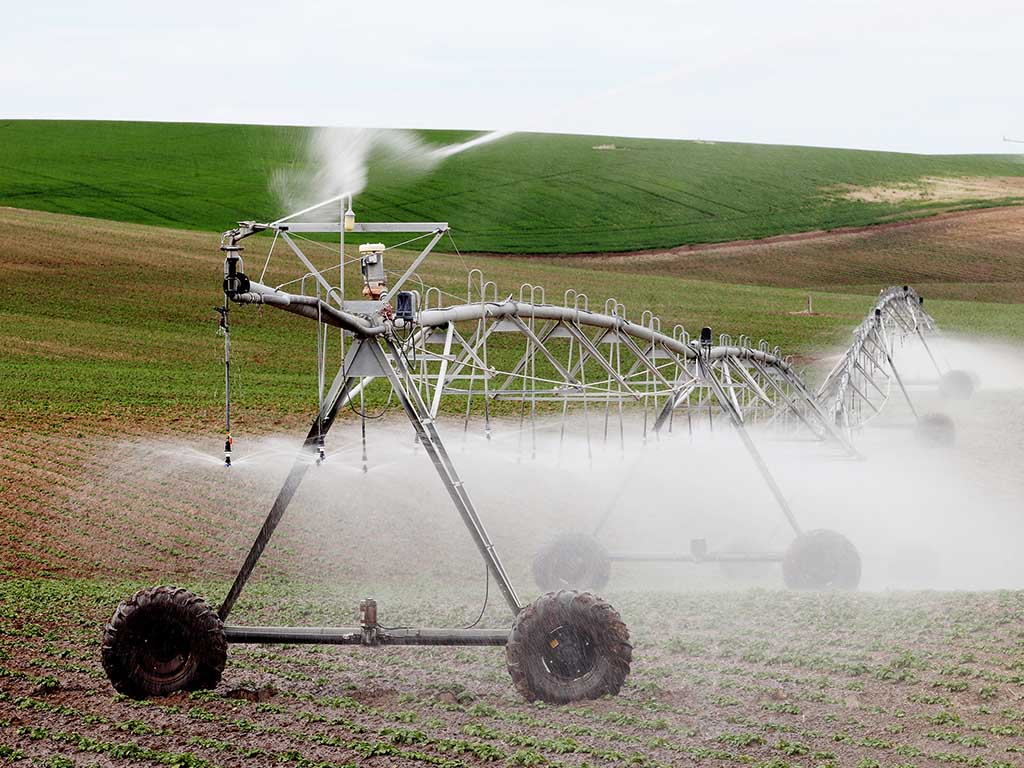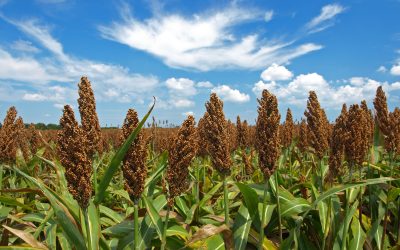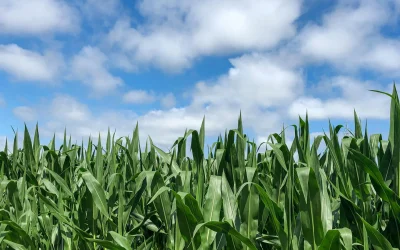Farmers irrigated more than 53 million acres of cropland in 2023, according to the United States Department of Agriculture’s latest Irrigation and Water Management Survey.1 For those growers, the extra costs associated with irrigation directly impact profitability. Let’s compare common irrigation methods and look at irrigation technologies that can help farmers optimize their water use efficiency.
How Much Does Irrigation Cost?
Irrigation costs can vary widely depending on the irrigation method, farm size, geography and application requirements. It’s estimated that U.S. farmers spent nearly $3 billion on irrigation equipment, facilities, land improvements and computer technology in 2023, while energy costs for pumping well and surface water totaled $3.3 billion.1
What Type of Irrigation Do Farmers Use?
There are different types of irrigation systems, and the most effective and efficient method depends on the type of crop being grown and its specific watering needs. Here are a few of the benefits and limitations of various agricultural irrigation methods.
Center-pivot irrigation
What it is: A center-pivot irrigation system delivers water to overhead sprinkler heads or nozzles in a circular pattern from a central pivot point. Towers spaced at regular intervals support an elevated pipe above the crops. The towers move in fixed circular paths, powered by pneumatic, mechanical, hydraulic or electric energy, ensuring a consistent speed as the pivot operates. The speed at which the system travels determines how much water reaches crops. Typically, a single unit can extend about 1,250 to 1,300 feet and irrigate approximately 130 acres within a circular area.
Where it’s effective: Center-pivot irrigation is most effective when used in large, generally flat fields. It’s one of the most common methods for irrigating crops like cotton, corn, soybeans and wheat in the west and midwestern United States.
Benefits:
- Ability to cover a large number of acres efficiently
- Supports the application of fertilizers and other crop inputs
- Minimal labor resources needed
- Uniform water distribution; ability to program applications based on field needs
- Less water loss compared to some irrigation methods
Limitations:
- High initial cost
- Requires consistent maintenance to maintain efficiency
- Circular irrigation pattern may require equipment supplements to meet whole-field irrigation needs
Estimated cost:
Irrigation investment and operating costs vary substantially across locations, based on access to water and electricity, the size and elevation of the field and other factors. The installation of a new center-pivot system can cost between $1,100 and $2,100 per irrigated acre.2
Drip irrigation
What it is: Drip irrigation is an efficient method of watering crops that provides water directly to the crop roots, drop by drop. It uses plastic tubing designed with emitters to control water flow. Irrigation tubing can be applied on the soil surface or buried, depending on the crop and farming practices. This system operates under low pressure, which helps conserve water while ensuring plants receive the moisture they need.
Where it’s effective: Drip irrigation is commonly used for high-value specialty crops, such as fruits and vegetables. It is also used in orchards, vineyards and greenhouse settings.
Benefits:
- Uses less water than sprinkler irrigation systems
- Suitable for a wide range of soil types and terrains
- Optimizes water use efficiency by reducing runoff and evaporation
- Keeps leaves dry, reducing the risk of plant diseases
- Less risk of nutrient leaching and soil erosion
- Reduced energy costs compared to other irrigation methods
Limitations:
- Potential for emitter clogging and damage
- Risk of salt accumulation in the root zone
- Sensitive to water quality
- More labor requirements for installation and maintenance
- High initial investment cost
Estimated cost: Drip irrigation costs will vary depending on water cost per gallon,
system type (surface or sub-surface), crop, water needs and maintenance and repair costs. Surface drip irrigation is generally less expensive, ranging from $500 to $3,000 per acre, while subsurface drip irrigation costs can range from $2,500 to $5,000 per acre.3
Flood or furrow irrigation
What it is: Flood irrigation involves covering the entire soil surface with ponded water, usually pumped from a nearby canal, river or reservoir. The water flows by gravity from higher to lower points in the field.
Furrow irrigation is a type of flood irrigation commonly used in row crops. Trenches dug between the crop rows distribute water through channels to the root zone.
Where it’s effective: Flood irrigation is often used in rice cultivation, where standing water is required for favorable crop growth. Flood irrigation may also be used in pasture or forage crops, while furrow irrigation is commonly used in row crops like cotton, soybeans, and corn.
Benefits:
- Simple to install and maintain
- Accessible to farmers with limited resources
- Low initial setup cost compared to other irrigation methods
Limitations:
- Inefficient water use — higher risk for evaporation and runoff losses
- Soil health impacts — increases erosion and salinity risks
- Can be labor-intensive to prepare fields and maintain irrigation channels
- Risk for nutrient leaching
- Uneven water distribution without proper field prep
Estimated cost: Compared to other irrigation methods, flood and furrow irrigation has a low initial setup cost, ranging from $200 to $400 per acre.4,5
Irrigation Technologies Can Improve Water Use Efficiency
Choosing the most appropriate irrigation method for the crop and its watering needs is the foundation for efficient and effective moisture management. When paired with precision agriculture irrigation technologies, farmers can further improve water use efficiency to save on irrigation costs. Here are a few irrigation innovations farmers may consider.
- Water Enhancing Technology
UpTerra’s water-enhancing technology, TerraFlow®, improves irrigation water use efficiency using two patented processes: vortexing and frequency imprinting. TerraFlow connects easily to most irrigation systems and simultaneously vortexes irrigation water to optimize its structure and imprints it with beneficial frequencies to reduce surface tension. These processes support more consistent water distribution across and into the soil profile, improving moisture availability for the plant. With TerraFlow, farmers have been able to reduce water use by up to 20% while maintaining or improving their crop yields.
- Drones and Remote Sensing for Irrigation Management
Drones and remote sensing technology enable farmers to monitor crop stress, soil moisture, and field conditions, allowing them to optimize when and where to apply irrigation. Drones can provide real-time data that feeds into precision irrigation systems, improving watering efficiency.
- Soil Moisture Sensors
Soil moisture monitoring devices, such as tensiometers or capacitance sensors, can help guide irrigation timing based on real-time soil water needs. Research has shown that tomato farmers who manage irrigation with soil moisture sensors applied up to 51% less irrigation water compared to a fixed-time irrigation plan and observed a crop yield increase of up to 26%.6
- Variable-Rate Irrigation
Variable-rate irrigation allows different amounts of water to be applied to different field zones, based on soil and crop variability. This type of precision irrigation ensures crops have the moisture they need while reducing the risks and costs associated with overwatering.
- Smart Irrigation Controllers
Smart irrigation controllers use weather data, forecasts and soil moisture information to adjust irrigation automatically. A literature review conducted by the American Society of Agricultural and Biological Engineers found that across soil types and environments, smart irrigation controllers reduced water use by an average of 50% in controlled trials.7
Top Barriers to Adopting Irrigation Technology
New technologies can help ensure growers get the most from each irrigation application, but there may be barriers to adoption. Of the farms surveyed in the USDA’s Irrigation Management census, 77% reported that the condition of their crop largely determines irrigation schedules. Only 15% of farms reported using plant or moisture sensing devices to guide irrigation timing.1
Farmers across the U.S. cite these reasons as the top barriers to making irrigation improvements that could help them conserve water and cut costs1:
- They can’t finance improvements.
- Investing in improvements is not a top priority.
- Improvements will not reduce costs enough to cover implementation costs.
Compared to many other irrigation technologies, TerraFlow has a low barrier to entry. A relatively low per-acre cost, plus leased equipment that is continuously updated and maintained, reduces the risk and implementation expenses for many growers. In addition to reducing irrigation costs and water use, TerraFlow contributes to long-term soil health. The longer a farmer uses TerraFlow, the more benefits they will see, including greater yield stability, more diverse microbial populations and better nutrient cycling over time.
Get the Most From Crop Irrigation Systems
Irrigation plays a crucial role in producing high-yielding, top-quality crops in the United States, but it’s also an added expense for farmers to manage. Finding the most cost-effective irrigation method requires research and a commitment to properly calibrating, maintaining and operating the system. Adding irrigation technologies like TerraFlow can help farmers maximize their irrigation efficiency while maintaining crop yields.
If you’re interested in learning more about how UpTerra’s water-enhancing technologies can improve irrigation efficiency on your farm, contact one of our local sales reps.
Resources
1 United States Department of Agriculture. 2023 Irrigation and Water Management Survey. 2024.
2 Alabama Cooperative Extension System. Investment Costs of Center Pivot Irrigation in Alabama—Three Scenarios. 2019.
3 Lockwood, J. Sub-Surface & Drip Irrigation Cost Calculator. 2025.
4 Farmstand App. 7 Tips for Choosing the Right Irrigation System for Your Crops That Maximize Yield. 2025.
5 Texas A&M AgriLife Extension. Economics of Irrigation Systems.
6 Zotarelli L, Scholberg J.M, Dukes M.D., et al. Tomato Yield, Biomass Accumulation, Root Distribution and Irrigation Water Use Efficiency on a Sandy Soil, As Affected By Nitrogen Rate and Irrigation Scheduling. Agric. Water Manag. 2009. 96, 23–34.
7 Transactions of the American Society of Agricultural and Biological Engineers. Two Decades of Smart Irrigation Controllers in U.S. Landscape Irrigation. 63(5): 1593-1601. 2020.



